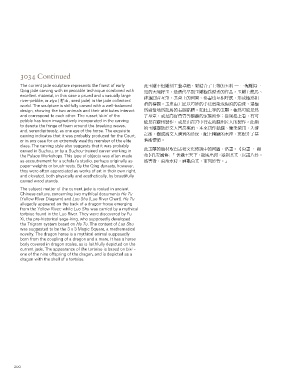Page 201 - Christie's Leisurely Life May 29, 2019 Hong Kong
P. 201
3034 Continued
The current jade sculpture represents the finest of early ᫉ℱ㫌Ӷֿ㫌ߴ႙⻱ࢴ⢞卿ᝤ⢙भԻӳ✙⎏ℱᙠ Ĝ Ӭ౩㫙ᇑӬ
Qing jade carving with impeccable technique combined with ⎏ഌ౩⟴ℱ卿ᛓ᳖ջឆℱ㫌ᥑἃܵ★⎏הǯℱ㫌ӳ䂆㲬Ǯ
excellent material, in this case a prized and unusually large ▵䂏୪㲛Մឃ卿ݯ⫫ӳ⎏ᯇஎǮᰞᝧԮՄ⏟ঈ卿ᆨᎰᥑἃক
river-pebble, or ziyu ( ⟴ℱ , seed jade) in the jade collectors’
world. The sculpture is skilfully carved with a well-balanced ㋞⎏ᦔஎǯℱ⎪⊐႙ࢎսႛ൘⎏ᏛᯧᳳᎰᱡ᱖⎏⎊ᮿ卿㚍ᥑ
design, showing the two animals and their attributes interact ἃ㙴ቲἃ䂆㲬⎏ठ␓㿽ǯൈ᫉ӳ✙⎏ℱ㫌卿ᥑἃज⬒ᛓἃ
and correspond to each other. The russet ‘skin’ of the Ի⎑ༀ卿Ꮅᛓ㵶㏟ݽ✙㰆㑂⎏།ᚉᏒה厎ᇖ㰍ᡟӳ⏭卿ᝳज
pebble has been imaginatively incorporated in the carving ⬒ᛓங⼖႔ㅳה卿Ꮅᛓ⊐ங༈ԋリ㑇⎏⼖႔ࢎ՞Ꮢㅳהǯ᫉㯸
to denote the fringe of foam around the breaking waves, ⎏ℱ㫌ᗥᘞᙻᙔ՞ᝧᏑᡪ㯔卿ទ⊇ה⡮㤯Ǯ✖៵ײ⊇卿ݣ᳖
and, serendipitously, as one eye of the horse. The exquisite
carving indicates that it was probably produced for the Court, Ԡᇌ卿᷉Ꮀἃᙔ՞᳖㐃⎏Ⅷ⅊卿㜩ӳ⠢⤤⎏ណᄠ卿ᝤᓽࢫԻݯ
or in any case for an extremely wealthy member of the elite ⻱ワٿǯ
class. The carving style also suggests that it was probably
carved in Suzhou, or by a Suzhou-trained carver working in ᫉ℱ㫌⎏㯪ឬइ⯇ऒ⩞ᙔࢇ۔㊯ԋ⎏ᯇஎǮᰞᝧǯǶབᝧ Ĥ 㰀
the Palace Workshops. This type of objects was often made উǷເஇ۔ Ǹ ֛⨙ℳӴ卿䂆㲬߅ᯇ卿㙖ߺݯᙔ卿ս⊺ݨࣀǯ
as accoutrement for a scholar’s studio, perhaps originally as ᰞᝧ⩢卿◿ᯎ᭢ᛞ卿▵䂏㏎ᙔ卿⩧ߛᙻ⫫ǯǹ
paper-weights or brush-rests. By the Qing dynasty, however,
they were often appreciated as works of art in their own right,
and elevated, both physically and aesthetically, by beautifully
carved wood stands.
The subject matter of the current jade is rooted in ancient
Chinese culture, concerning two mythical documents He Tu
(Yellow River Diagram) and Luo Shu (Luo River Chart). He Tu
allegedly appeared on the back of a dragon-horse emerging
from the Yellow River; while Luo Shu was carried by a mythical
tortoise found in the Luo River. They were discovered by Fu
Xi, the pre-historical sage-king, who supposedly developed
the Trigram system based on He Tu. The content of Luo Shu
was suggested to be the 3 x 3 Magic Square, a mathematical
novelty. The dragon horse is a mythical animal supposedly
born from the coupling of a dragon and a mare. It has a horse
body covered in dragon scales, as is faithfully depicted on the
current jade. The appearance of the tortoise is based on bixi –
one of the nine offspring of the dragon, and is depicted as a
dragon with the shell of a tortoise.
200

